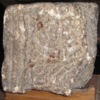Fragment of Saxon cross - Kingston upon Thames
Title
Fragment of Saxon cross - Kingston upon Thames
Subject
Archaeology
Description
Kingston upon Thames, or Cyninges-tun as it was known in Saxon times, plays an important part in Anglo-Saxon history, for two main reasons. First, in 838 AD King Egbert of Wessex held a Great Council at Kingston. The Council was attended by the king’s noblemen, Archbishop Coelnoth of Canterbury and twenty-four bishops, and at it was made a compact of mutual support between Church and State by which the bishops were given rank in the State as “spiritual lords” - a settlement which persists to this day in the right of twenty-four bishops (and two archbishops) to sit in the House of Lords.
Second, Kingston was the site of the coronation of at least two, and possibly as many as seven, Saxon Kings. One of those Kings was Athelstan, crowned at Kingston on 4 September 925 AD. He is generally regarded as the first man who could properly be called King of England.
There is now no trace of the buildings in which these events took place, although it is almost certain that the present church of All Saints, the earliest parts of which are Norman, was built on the same site. There are records of a Saxon stone church on the site which finally collapsed in 1730 but it is thought that there was at least one wooden church on the site before that was built.
This picture is of a fragment of stone found when All Saints was being restored to the plans of the Victorian architect J L Pearson. It was found built into the walls of the church, having previously (we think) been used as building material at the time of the erection of the Norman church in c. 1120-30. Although it is only a fragment, having been broken away at the back as well as above and below, enough remains to show that its two sides were decorated with elaborately contrived interlaced patterns carved in relief. The form of these patterns, and the fact that the sides themselves are also slightly tapered, makes it almost certain that the stone once formed part of the shaft of a tall stone cross which would probably have stood in the open in the churchyard. Whatever carving there may have been on the front of the shaft has been so rubbed away as to be quite unrecognisable, while the side decoration is itself so worn and incomplete as to make only the most approximate dating possible. We can however say that the cross would have been erected at some time between the late seventh and the early eleventh century, so it is possible that it would have been standing at the time of the coronation of Athelstan, or even at the Great Council of 838.
Second, Kingston was the site of the coronation of at least two, and possibly as many as seven, Saxon Kings. One of those Kings was Athelstan, crowned at Kingston on 4 September 925 AD. He is generally regarded as the first man who could properly be called King of England.
There is now no trace of the buildings in which these events took place, although it is almost certain that the present church of All Saints, the earliest parts of which are Norman, was built on the same site. There are records of a Saxon stone church on the site which finally collapsed in 1730 but it is thought that there was at least one wooden church on the site before that was built.
This picture is of a fragment of stone found when All Saints was being restored to the plans of the Victorian architect J L Pearson. It was found built into the walls of the church, having previously (we think) been used as building material at the time of the erection of the Norman church in c. 1120-30. Although it is only a fragment, having been broken away at the back as well as above and below, enough remains to show that its two sides were decorated with elaborately contrived interlaced patterns carved in relief. The form of these patterns, and the fact that the sides themselves are also slightly tapered, makes it almost certain that the stone once formed part of the shaft of a tall stone cross which would probably have stood in the open in the churchyard. Whatever carving there may have been on the front of the shaft has been so rubbed away as to be quite unrecognisable, while the side decoration is itself so worn and incomplete as to make only the most approximate dating possible. We can however say that the cross would have been erected at some time between the late seventh and the early eleventh century, so it is possible that it would have been standing at the time of the coronation of Athelstan, or even at the Great Council of 838.
Creator
Keith Long
Date
Late seventh to early eleventh century
Language
English
Date Created
2010-08-04
Files
Citation
Keith Long, “Fragment of Saxon cross - Kingston upon Thames,” Woruldhord, accessed April 29, 2024, http://poppy.nsms.ox.ac.uk/woruldhord/items/show/180.

